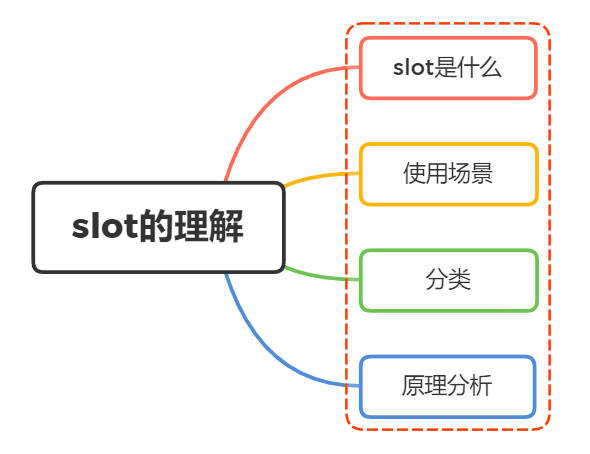# 面试官:说说你对slot的理解?slot使用场景有哪些?

# 一、slot是什么
在HTML中 slot 元素 ,作为 Web Components 技术套件的一部分,是Web组件内的一个占位符
该占位符可以在后期使用自己的标记语言填充
举个栗子
<template id="element-details-template">
<slot name="element-name">Slot template</slot>
</template>
<element-details>
<span slot="element-name">1</span>
</element-details>
<element-details>
<span slot="element-name">2</span>
</element-details>
template不会展示到页面中,需要用先获取它的引用,然后添加到DOM中,
customElements.define('element-details',
class extends HTMLElement {
constructor() {
super();
const template = document
.getElementById('element-details-template')
.content;
const shadowRoot = this.attachShadow({mode: 'open'})
.appendChild(template.cloneNode(true));
}
})
在Vue中的概念也是如此
Slot 艺名插槽,花名“占坑”,我们可以理解为solt在组件模板中占好了位置,当使用该组件标签时候,组件标签里面的内容就会自动填坑(替换组件模板中slot位置),作为承载分发内容的出口
可以将其类比为插卡式的FC游戏机,游戏机暴露卡槽(插槽)让用户插入不同的游戏磁条(自定义内容)
放张图感受一下

# 二、使用场景
通过插槽可以让用户可以拓展组件,去更好地复用组件和对其做定制化处理
如果父组件在使用到一个复用组件的时候,获取这个组件在不同的地方有少量的更改,如果去重写组件是一件不明智的事情
通过slot插槽向组件内部指定位置传递内容,完成这个复用组件在不同场景的应用
比如布局组件、表格列、下拉选、弹框显示内容等
# 三、分类
slot可以分来以下三种:
- 默认插槽
- 具名插槽
- 作用域插槽
# 默认插槽
子组件用<slot>标签来确定渲染的位置,标签里面可以放DOM结构,当父组件使用的时候没有往插槽传入内容,标签内DOM结构就会显示在页面
父组件在使用的时候,直接在子组件的标签内写入内容即可
子组件Child.vue
<template>
<slot>
<p>插槽后备的内容</p>
</slot>
</template>
父组件
<Child>
<div>默认插槽</div>
</Child>
# 具名插槽
子组件用name属性来表示插槽的名字,不传为默认插槽
父组件中在使用时在默认插槽的基础上加上slot属性,值为子组件插槽name属性值
子组件Child.vue
<template>
<slot>插槽后备的内容</slot>
<slot name="content">插槽后备的内容</slot>
</template>
父组件
<child>
<template v-slot:default>具名插槽</template>
<!-- 具名插槽⽤插槽名做参数 -->
<template v-slot:content>内容...</template>
</child>
# 作用域插槽
子组件在作用域上绑定属性来将子组件的信息传给父组件使用,这些属性会被挂在父组件v-slot接受的对象上
父组件中在使用时通过v-slot:(简写:#)获取子组件的信息,在内容中使用
子组件Child.vue
<template>
<slot name="footer" testProps="子组件的值">
<h3>没传footer插槽</h3>
</slot>
</template>
父组件
<child>
<!-- 把v-slot的值指定为作⽤域上下⽂对象 -->
<template v-slot:default="slotProps">
来⾃⼦组件数据:{{slotProps.testProps}}
</template>
<template #default="slotProps">
来⾃⼦组件数据:{{slotProps.testProps}}
</template>
</child>
# 小结:
v-slot属性只能在<template>上使用,但在只有默认插槽时可以在组件标签上使用- 默认插槽名为
default,可以省略default直接写v-slot - 缩写为
#时不能不写参数,写成#default - 可以通过解构获取
v-slot={user},还可以重命名v-slot="{user: newName}"和定义默认值v-slot="{user = '默认值'}"
# 四、原理分析
slot本质上是返回VNode的函数,一般情况下,Vue中的组件要渲染到页面上需要经过template -> render function -> VNode -> DOM 过程,这里看看slot如何实现:
编写一个buttonCounter组件,使用匿名插槽
Vue.component('button-counter', {
template: '<div> <slot>我是默认内容</slot></div>'
})
使用该组件
new Vue({
el: '#app',
template: '<button-counter><span>我是slot传入内容</span></button-counter>',
components:{buttonCounter}
})
获取buttonCounter组件渲染函数
(function anonymous(
) {
with(this){return _c('div',[_t("default",[_v("我是默认内容")])],2)}
})
_v表示穿件普通文本节点,_t表示渲染插槽的函数
渲染插槽函数renderSlot(做了简化)
function renderSlot (
name,
fallback,
props,
bindObject
) {
// 得到渲染插槽内容的函数
var scopedSlotFn = this.$scopedSlots[name];
var nodes;
// 如果存在插槽渲染函数,则执行插槽渲染函数,生成nodes节点返回
// 否则使用默认值
nodes = scopedSlotFn(props) || fallback;
return nodes;
}
name属性表示定义插槽的名字,默认值为default,fallback表示子组件中的slot节点的默认值
关于this.$scopredSlots是什么,我们可以先看看vm.slot
function initRender (vm) {
...
vm.$slots = resolveSlots(options._renderChildren, renderContext);
...
}
resolveSlots函数会对children节点做归类和过滤处理,返回slots
function resolveSlots (
children,
context
) {
if (!children || !children.length) {
return {}
}
var slots = {};
for (var i = 0, l = children.length; i < l; i++) {
var child = children[i];
var data = child.data;
// remove slot attribute if the node is resolved as a Vue slot node
if (data && data.attrs && data.attrs.slot) {
delete data.attrs.slot;
}
// named slots should only be respected if the vnode was rendered in the
// same context.
if ((child.context === context || child.fnContext === context) &&
data && data.slot != null
) {
// 如果slot存在(slot="header") 则拿对应的值作为key
var name = data.slot;
var slot = (slots[name] || (slots[name] = []));
// 如果是tempalte元素 则把template的children添加进数组中,这也就是为什么你写的template标签并不会渲染成另一个标签到页面
if (child.tag === 'template') {
slot.push.apply(slot, child.children || []);
} else {
slot.push(child);
}
} else {
// 如果没有就默认是default
(slots.default || (slots.default = [])).push(child);
}
}
// ignore slots that contains only whitespace
for (var name$1 in slots) {
if (slots[name$1].every(isWhitespace)) {
delete slots[name$1];
}
}
return slots
}
_render渲染函数通过normalizeScopedSlots得到vm.$scopedSlots
vm.$scopedSlots = normalizeScopedSlots(
_parentVnode.data.scopedSlots,
vm.$slots,
vm.$scopedSlots
);
作用域插槽中父组件能够得到子组件的值是因为在renderSlot的时候执行会传入props,也就是上述_t第三个参数,父组件则能够得到子组件传递过来的值
# 参考文献
- https://juejin.cn/post/6844903817746628615#heading-4
- https://developer.mozilla.org/en-US/docs/Web/Web_Components/Using_templates_and_slots
- https://vue3js.cn/docs/zh
- https://segmentfault.com/a/1190000019492734?utm_source=tag-newest
